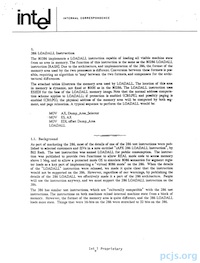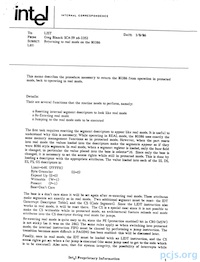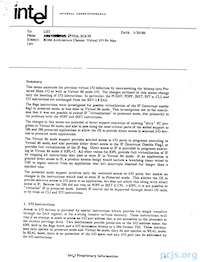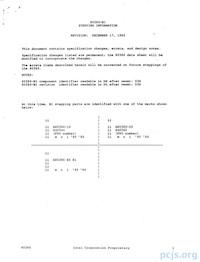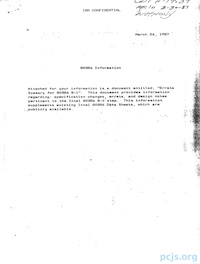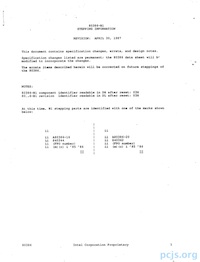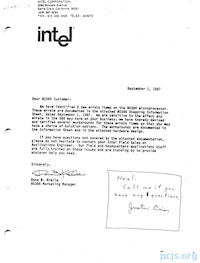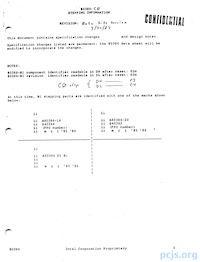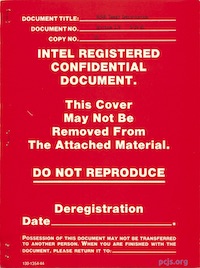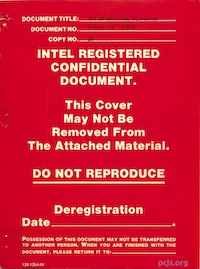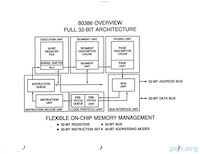PCjs Machines
Home of the original IBM PC emulator for browsers.

Intel 80386 CPU Information
80386 Steppings
As the “INTEL 80386 PROGRAMMER’S REFERENCE MANUAL 1986”, section 10.1, explains:
The contents of EAX depend upon the results of the power-up self test. The self-test may be requested externally by assertion of BUSY# at the end of RESET. The EAX register holds zero if the 80386 passed the test. A nonzero value in EAX after self-test indicates that the particular 80386 unit is faulty. If the self-test is not requested, the contents of EAX after RESET is undefined.
DX holds a component identifier and revision number after RESET as Figure 10-1 illustrates. DH contains 3, which indicates an 80386 component. DL contains a unique identifier of the revision level.
However, at this late date, it is unclear exactly what steppings Intel released and what “revision level”, if any, was associated with each stepping.
- A0 Stepping
- A1 Stepping
- A2 Stepping
- B0 Stepping
- B1 Stepping
- C0 Stepping
- D0 Stepping
- D1 Stepping
- D2 Stepping
A0 Stepping
The first 80386 stepping had serious problems, including an inability to return to real mode (reminiscent of the 80286). Apparently, it was never released commercially, and we know very little about it.
A1 Stepping
From “Advanced 80386 Programming Techniques” by James L. Turley (C) 1988:
This is the first revision after the initial (A0) introduction of the 80386 [in late 1985]. The A1 stepping became available around the first of the year in 1986.
- Hardware Peculiarity: Unless pin F13 of the 80386 is connected to the +5V power supply, the 80386 never terminates a memory cycle, hanging the processor.
- Loading LDTR with a Null Selector: If you load the local descriptor table register with a null selector (0000 through 0003) without performing a memory read immediately afterward, the 80386 behaves erratically. LDTR can be loaded either as the result of an LLDT instruction or as part of a task-switch operation if the incoming TSS has a null selector in its LDT field.
- Loading Bad Stack Selectors: The 80386 does not check the privilege level of the desired stack segment selector during an LSS instruction. Normally, the RPL of the selector and the DPL of the segment must exactly equal the DPL of the currently executing code segment.
- Misaligned Selectors: If a 16-bit memory operand is loaded into a segment register, the 80386 hangs if the selector is not word-aligned. This can happen with a MOV instruction and with the LDS, LES, LFS, LGS, and LSS instructions.
- Testing Null Selectors: The 80386 hangs if an LAR, LSL, VERR, or VERW instruction is used to test a null selector.
- Popping Selectors: When popping a segment selector from the stack, the 80386 performs all of the privilege-related checks backward. That is, you are allowed to pop a selector to a segment with more privilege, but not to one with less privilege.
- Indirect FAR JMP to Same Privilege Level: An indirect JMP instruction is one in which the new segment selector and offset are stored in memory. If the new code segment is at the same privilege level as the current code segment, the 80386 does not read the selector portion of the JMP operand. The result is a NEAR JMP to a new offset within the current code segment.
- Spurious Breakpoint Exceptions: A MOV instruction into or out of the debug registers while hardware breakpoints are enabled may cause a breakpoint fault to be reported. You should temporarily disable the hardware breakpoints while reading or writing the debug registers and then execute a JMP instruction to flush the prefetch queue before reenabling them.
- Successive Floating-Point Instructions: If two floating-point instructions are executed close together, the 80386 may force the coprocessor to start the second one too soon if the first one did not require any memory operands.
- Bad Floating-Point Instructions: The execution of certain undefined floating-point instructions causes the 80386 to hang rather than reporting an invalid instruction fault.
- Misaligned Floating-Point Instructions: If 80287 and/or 80387 instructions are not word-aligned, the 80386 passes the wrong instruction to the coprocessor, causing unpredictable behavior.
- Misaligned Descriptor Tables: All segment descriptors should be dword-aligned, or the 80386 may not read them correctly.
- Incorrect Interrupt Vector: If a maskable interrupt occurs immediately after the 80386 has executed an instruction with an 8-bit operand, the interrupt is always assigned a vector number of 0.
- Handling Exceptions with 80286 Tasks: If an exception that pushes an error code is handled through a task gate to an 80286 task, the 80386 generates a double fault (exception 8) as soon as the 80286 task switch is completed.
- Page Fault During Task Switch: If the new task uses different page tables than the old task and a page fault occurs during the task-switch operation, the 80386 hangs instead of reporting the page fault.
- Returning from a Nested Task: If you execute an IRET instruction when the NT (Nested Task) flag in EFLAGS is set, the 80386 returns to your “parent” task. However, it will neglect to clear NT in the outgoing task’s TSS.
- Task-Switch Trap Bit: When a task switch occurs and the incoming TSS has its task-switch bit set, the 80386 generates a debug fault (exception 1). However, it will neglect to set the BT flag in register DR6 before invoking the exception 1 handler.
- Invalid TSS Faults: When an invalid TSS fault (exception 10) occurs as the result of a task-switch operation, the 80386 pushes the wrong values for EIP and ESP on the error handler’s stack.
- Wrong Paging Information During Task Switch: When a task switch occurs and the new task uses a different set of page tables than the old task (that is, CR3 in the TSS is different), the 80386 reads the new TSS descriptor and updates the old TSS using the page tables of the new task.
- Masking NMI: If an NMI is serviced through a task gate, the 80386 neglects to reenable NMI inputs after the NMI-handling task terminates. The 80386 does not recognize NMI inputs while it is servicing an NMI.
- Incorrect Error Code: If an exception that pushes an error code is handled through a task gate, the 80386 may push an error code of 0 instead of the correct error code.
- Not-Present LDT: If a task switch occurs and the new task’s TSS selector selects an LDT descriptor that is marked no present, the 80386 reports a not-present fault (exception 11), instead of an invalid TSS (exception 10).
- Self-test: The self-test feature does not work on the A1 stepping of the 80386.
- Interlevel Transfers: If you perform a control transfer to a higher privilege level and the procedure at that level uses an expand-down stack segment for its stack, as opposed to an expand-up data segment, the 80386 generates a spurious stack fault (exception 12).
- Debug Access Fault: If an attempt is made to read or write the debug registers while GD is set in DR7, the 80386 generates a debug fault (exception 1). However, the wrong value for EIP will be pushed onto the exception handler’s stack.
- Multiply and Divide Errors: If the 80386 executes a MUL, IMUL, DIV, or IDIV instruction with a memory operand and general protection fault (exception 13) occurs, the processor hangs rather than reporting the fault.
- Intersegment Transfers: If the last 2 bytes of a direct FAR JMP or FAR CALL instruction are beyond the end of the code segment, the 80386 hangs rather than reporting a general protection fault.
- Intersegment Transfers II: If the last 2 bytes of a direct FAR JMP or FAR CALL instruction lie on the other side of a page boundary, the 80386 hangs, regardless of whether the other page is present or not. Remember, a page boundary occurs every 4kb.
- Bit-Test Instructions: The bit-test instructions that perform read-modify-write cycles to memory (BTC, BTR, and BTS) do not work properly unless your memory runs without wait states.
- Bit Scan Forward Instruction: If a BSF instruction is executed with a memory operand, and a general protection fault (exception 13) or a page fault (exception 14) occurs, the 80386 hangs rather than reporting the fault.
- Accessing CR3, TR6, and TR7: Reading or writing registers CR3, TR6, or TR7 produces incorrect results if your memory requires wait states. This is particularly obscure, since these instructions do not reference memory.
A2 Stepping
We didn’t even know this was “a thing” until Michal Necasek ran across this “Inside Track” article in PC Magazine, February 24, 1987, by John C. Dvorak:
80386 Bug Stopper Dept.: If you buy an 80386 machine, card, or chip, make sure you get the B1 revision of the chip or something newer (B2, B3, and so on). There are far too many bugs in the A1 and A2 versions of the chip to be acceptable. Here’s what to look for: On the top line of the chip you’ll see the designation A80386-16. If it says A80386-16ES, then it’s an engineering sample and the vendor is a cheapskate. The samples have the revision number on the top line as A1, A2, or B1. Look no further.
For the rest of you, look at the second line on the chip. If it’s S40344 then you have a B1 chip. S40334 is the A2 revision and S40276 is the A1 revision….
B0 Stepping
From “Advanced 80386 Programming Techniques” by James L. Turley (C) 1988:
The B0 stepping became available around the middle of 1986. As is the case with earlier steppings, the “B0” marking can sometimes be found on the outside of the device. If not, the code “S40336” or “S40337” may appear. Starting with the B0 stepping, the 80386 would leave the component identifier, 3, in DH and the revision identifier, also 3, in DL [These B0 values need to be independently confirmed, because they are the same values reported for the B1 stepping. -JP]
- Interrupts and Privilege Violations: If a hardware interrupt occurs immediately before an IOPL-sensitive instruction when CPL is greater than IOPL, the 80386 behaves erratically. Generally, it will produce spurious stack faults (exception 12). Note that this occurs only if the IOPL-sensitive instruction was going to fail.
- Infinite Page Faults: If a page fault (exception 14) occurs while the 80386 is attempting to invoke a page fault handler, it generates another page fault rather than reporting a double fault (exception 8).
- Invalid TSS Fault: If an invalid TSS fault (exception 10) is caused by an attempt to switch to a TSS that is too small, and the exception is handled through a task gate, the 80386 shuts down.
- Invalid TSS Fault II: If you execute an IRET instruction while the NT (Nested Task) flag is set in EFLAGS, and the “parent” TSS is too small, the 80386 generates a double fault (exception 8).
- Invalid TSS Fault III: If the previous error occurs and the double fault is handled through a trap gate, the 80386 shuts down.
- Invalid TSS Fault IV: If the gate descriptor for an invalid TSS fault (exception 10) is bad and an invalid TSS fault occurs for any reason, the 80386 shuts down.
- Tracing a REP MOVS Instruction: The 80386 does not correctly single-step (trace) repeated string move instructions. Instead, it generates a debug trap after every other iteration of the repeated MOVS instruction.
- Breakpointing a REP MOVS Instruction: If a data breakpoint is enabled and it is hit during a repeated string move instruction, the 80386 reports it only after an even number of iterations. This gives you a fifty-fifty chance of learning about your breakpoint one instruction late.
- 16-Bit and 32-Bit Control Transfers: Whenever control is transferred from 16-bit code to 32-bit code through a task gate or through a gate that causes a change in privilege level, the 80386 discards the upper half of the offset address in EIP. If the destination address was greater than 64Kb, this will cause a program error.
- 16-Bit and 32-Bit Control Transfers II: When an IRET instruction that transfers control to a Virtual 8086 mode task is executed, the 80386 neglects to truncate the offset address on the stack to 16 bits.
- 16-Bit and 32-Bit Control Transfers III: If a 32-bit call, trap, or interrupt gate is used to transfer control from a 16-bit code segment to a 32-bit code segment without changing privilege levels, the 80386 treats the gate as a 16-bit gate.
- Mixing Address Sizes: If a LOOP, MOVS, LODS, STOS, CMPS, INS, or OUTS instruction is followed by an instruction that uses a different address size, the 80386 may use the incorrect address size when updating either the loop counter or the string index.
PC Magazine, October 15, 1991 confirms what Turley noted above:
You can tell if you have a B0 or B1 Step level 386 by looking at the markings on the chip. If it has the ID number S40336 or S40337 stamped on it, then it’s a Step B0; if it’s marked with S40343, S40344, or S40362, it’s a Step B1. Some B0 and B1 chips were marked B0 or B1 rather than with an ID number.
B1 Stepping
From a December 17, 1986 Intel document titled “80386-B1 STEPPING INFORMATION”:
80386-B1 component identifier readable in DH after reset: 03H
80386-B1 revision identifier readable in DL after reset: 03H
At this time, B1 stepping parts are identified with one of the marks shown
below:
|
ii | ii
|
ii A80386-16 | ii A80386-20
ii S40344 | ii S40362
ii (FPO number) | ii (FPO number)
ii m c i '85 '86 | ii m c i '85 '86
|
----------------------------------- ----------------------------------
|
ii |
|
ii A80386 ES B1 |
ii |
ii |
ii m c i '85 '86 |
|
Since the B1 stepping set DL to 0x03 on reset, this would lead one to believe that the revision number for a B0 stepping was 0x02, but according to Turley (see above), the B0 and B1 steppings report the same revision; as noted above, it would be nice to see some independent confirmation.
The 80386 CPU on my COMPAQ DeskPro 386 “Version 2” System Board is labeled as:
A80386-16
S40344
L8260347
(m)(c)i '85 '86
The “S40344” indicates that it’s a B1 stepping, although I’m not currently able to power it and run any tests.
According to OS/2 Museum proprietor Michal Necasek, the “L8260347” means:
[I]t was actually manufactured in mid-1988. It took me many years to realize how Intel marked the chips.
The initial 'L' (or whatever number/letter it is) can be ignored and the following 3 digits (826) are the
date code. The first is the last digit of the year.... The last two digits are the week of manufacture,
so week 26 of 1988. Many Intel CPUs actually have 2 or 3 date codes on them, probably related to when the
die was made, when the package was assembled, and when it was tested/binned and stamped. On your 386,
there might be another date code on the bottom side, but if there is, it's not going to be too far apart
from the one on the top and it's going to be slightly older.
Fortunately, my 80386-B1 CPU is also marked with a “ΣΣ” (double sigma), which is how Intel marked parts that tested safe for 32-bit multiplication. Some 80386 CPUs suffered from a manufacturing defect that could occasionally result in multiplication errors; defective parts that Intel caught were marked with “16 BIT S/W ONLY” instead of the double sigma.
B1 Errata
It’s fair to say that early 80386 steppings had a lot of problems. But that’s not terribly surprising, considering the 80386’s leap in functionality: a new 32-bit architecture that included paging and virtual 8086 mode, while also maintaining 16-bit protected-mode compatibility with the 80286, not to mention real-mode compatibility with the 8086.
Here’s what the world knew about 80386 problems in the B1 stepping, as of December 17, 1986:
-
Opcode Field Incorrect for FSAVE and FSTENV
Problem: If an FSAVE or an FSTENV is executed in REAL mode or in VIRTUAL 8086 mode, the opcode field stored in memory is incorrect if it should have referred to a coprocessor instruction which transfers either two bytes or ten bytes from memory to the coprocessor. The instruction and operand linear address fields are correctly stored. Note that coprocessor error-handling routines are the only routines possibly affected. Also note that the problem does not occur in PROTECTED mode programs (since no opcode is saved by FSAVE or FSTENV in that case).
Workaround: In REAL mode or in VIRTUAL 8086 mode, the instruction linear address field can be used to read the opcode from memory. Note that the two bytes fetched need to be swapped to yield the image that FSAVE and FSTENV normally stores.
-
FSAVE, FRESTOR, FSTENV and FLDENV Anomolies [sic] with Paging
Problem: If either of the last two bytes of an FSAVE or an FSTENV operand are for any reason not writeable, or either of the last two bytes of an FRESTOR or FLDENV are for any reason not readable, the instruction is not restartable.
Workaround: This does not not affect typical systems with reasonably-assigned page access rights. In an obscure situation where this problem arises, a workaround is to avoid having the operand of these instructions span a page boundary. This can be accomplished by aligning these operands on any 128-byte boundary.
-
Wraparound Coprocessor Operands
Problem: This can affect only situations where a coprocessor operand straddles the limit of a segment of maximum size (i.e. 0FFFFh for a 16-bit segment or 0FFFFFFFFh for a 32-bit segment) or within 108 bytes of maximum size, thus wrapping around to offset 0 of the segment. Since a wraparound situation is very abnormal for a compiler or programmer to create, this does not affect a typical system.
Formally, the 80386 architecture does not permit an operand (coprocessor operands included) to wrap around the end of a segment. If the user issues such an instruction nonetheless in a Protected Mode system, and the operand starts and ends in valid, present pages of a segment, BUT spans through an invalid or inaccessible page, the coprocessor may be put in an indeterminate state. In such cases, an FCLEX or FINIT instruction needs to be executed before any other coprocessor instruction is issued.
Workaround: In Real Mode, this is not a problem since protection is not enabled. In Protected Mode, this problem is avoided simply by not creating coprocessor operands which wrap around the end of the segment, or by aligning the base of all segments on page boundaries.
-
IRET to TSS with Limit too Small
Problem: If an IRET performs a task switch to a TSS of proper descriptor type but invalid (too small) limit, a Double Fault (exception 8) will result instead of a Invalid TSS Fault (exception 10) as should result. Furthermore, if the Double Fault entry in the IDT is a trap gate, a shutdown results. In a related topic, if the TSS Fault entry in the IDT is invalid for any reason (e.g. bad AR byte), then instead of a Double Fault (exception 8), a shutdown results.
Workaround: A working system, one that creates TSS segments of adequate size to hold the processor state (44 bytes for the TSS of a 16-bit task, 104 bytes for the TSS of a 32-bit task), will not encounter any problems here. A working system should also provide a valid gate (interrupt, trap, or task gate) in the IDT for exception 8.
-
Single-Stepping First Iteration of REP MOVS
Problem: If a REPeated MOVS instruction is executed when single-stepping is enabled (TF = 1 in EFLAGS register), a single-step trap (exception 1) is taken every two move steps, but should occur each move step. Also, if a data breakpoint is hit during a odd iteration number of REP MOVS, the data breakpoint trap is not taken until after the next even-numbered iteration. If the REP MOVS ends with an odd number of iterations, and single-stepping or data breakpoints are enabled, then a single-step trap or data breakpoint trap on the final iteration will properly occur after the final, odd-numbered iteration.
Workaround: When using the Trap Flag or data breakpoints with a debugger utility, this minor variation of REP MOVS must be accepted, unless an effort is made to have the debugger emulate the REP MOVS rather than actually execute it.
-
Task Switch to Virtual 8086 Mode Doesn’t Update Prefetch Limit
Problem: When a task switch to Virtual 8086 Mode is performed, the prefetch limit is not updated to become 0FFFFh, but instead remains at its previous value.
Workaround: Use the IRET instruction to transfer to Virtual 8086 Mode. Using IRET is the preferred method for most instances, especially when the master OS dispatches a Virtual 8086 Mode program, because IRET can cause the transition without a task switch.
-
Wrong Register Size for String Instructions in Mixed 16/32-bit Addressing Systems
Problem: If certain string and loop instructions are followed by instructions that either:
- use a different address size (that is, if either the string instruction or the following instruction uses an address size prefix), or
- reference the stack (e.g. PUSH/POP/CALL/RET) and the “B” bit in the SS descriptor is different from the address size used by the string instructions,
then one or more of [E]CX, [E]SI, or [E]DI is not updated properly. The size of the register (16 vs. 32) is taken from the following instruction rather than from the string or loop instruction. This could result in updating only the lower 16 bits of a 32-bit register, or in updating all 32 bits of a register being used as 16 bits. The instructions (and registers) affected by this are:
MOVS ([E]DI), REP MOVS ([E]SI), STOS ([E]DI), INS ([E]DI), and REP INS ([E]CX).Workaround: No workaround is necessary if all code is 16-bit or if all code is 32-bit. The problem only occurs if instructions with different address sizes are mixed together, or if a code segment of one size is used with a stack segment of the other size.
In a system which mixes address sizes, add a NOP after each of the above instructions and ensure that the NOP has the same address size as the string/loop (i.e., if the string/loop instruction includes an address prefix, place the same address prefix before the NOP; conversely, if the string/loop instruction does not have an address prefix, do not place a prefix before the NOP).
-
FAR Jump Located Near Page Boundary in Virtual 8086 Mode Paged Systems
Problem: In Virtual 8086 Mode, if a direct FAR jump (opcode EAh) instruction is located at the end of a page (or within 16 bytes of the end), and the next page is not cached in the TLB, the prefetcher limit is not set by the FAR jump instruction to the “end” on the new code segment, but rather is left at the “end” of the old code segment. This can allow execution beyond the end of the new segment without triggering a segment limit violation. Or it can result in a spurious GP fault if the old and new segments overlap, and a prefetch occurs beyond the limit of the old segment.
Note that the prefetch limit is checked on the linear address, not by comparing IP to 0FFFFh.
Workaround: All existing 8086 programs use only 16-bit addressing, and thus will not execute code at offsets greater than 0FFFFh from the code segment base. Thus the lack of detection of walking off the end of a code segment should not impact working 8086 programs.
A workaround to the spurious GP fault, if it occurs, is to simply IRET back to the faulting instruction, since the IRET will correctly set the prefetch limit. If the fault handler has control of the single-step function, a very simple workaround is to attempt to single-step the faulting instruction. If the single-step succeeded, the handler could clear the fault, turn off single-stepping, and IRET. If a GP fault occurred attempting to single-step the instruction, a “real” GP fault is the cause.
If the fault handler cannot access the single-stepping function, it still can check for “real” GP faults which must be emulated by the master OS, for example, I/O instructions that need to be emulated, CLI/STI instructions that must be emulated, etc. If none of these faults are recognized, the fault handler can assume this errata caused the GP fault and simply IRET back to the instruction.
-
Page Fault Error Code on Stack Not Reliable
Problem: When a Page Fault (exception 14) occurs, the 3 defined bits in the error code may be unreliable if a certain sequence of prefetch is happening at the same time.
Workaround: Although the page fault error code pushed onto the page fault handler’s stack can be unreliable, as described, the page fault linear address stored in register CR2 is always correct. The page fault handler should refer to the page fault linear address in CR2 to access the corresponding page table entry and thereby determine whether the page fault was due to a page “not present” condition, or to a usage violation.
-
Certain I/O Addresses Incorrect when Paging is Enabled
Problem: When Paging is enabled, accessing I/O addresses in the range 00001000h-0000FFFFh (4K through 64K-1) or accessing coprocessor ports (I/O addresses 800000F8h-800000FFh) as a result of executing coprocessor opcodes, can generate incorrect I/O addresses if paging is enabled and the corresponding linear memory address is marked “present” and “dirty.”
Furthermore, when paging has been enabled and is then turned off, paging translation continues to occur for memory or I/O cycles (I/O as described above) to linear addresses still stored in the TLB, but paging does not occur for linear addresses that result in a TLB miss.
Workaround: Unless paging is used, this item is not a problem. If paging is used but all I/O ports are below 00001000h (as in a PC DOS system), then I/O is no problem.
If paging is used and I/O ports exist in the range 0000l000h-0000FFFFh, then either have the memory pages at those linear addresses marked “not present” (to avoid having those pages table entries cached in the TLB), or if “present,” have those pages mapped such that bits 12-15 of the physical address equal bits 12-15 of the linear address. Alternatively, re-assign any I/O ports in the range 00001000h-0000FFFFh to below 00001000h.
If paging is used and the coprocessor is also used, then have the memory page at linear address 80000xxxh either marked “not present” (to avoid having that page table entry cached in the TLB), or if “present,” have the page mapped such that bit 31 (the most significant bit) of that page’s physical address is a 1.
To completely disable 80386 paging when paging was previously enabled, the 80386 TLB should be flushed immediately after resetting the~PG bit in CRO. The TLB can be flushed, you recall, by writing a Page Table Directory base address to register CR3.
-
Wrong ECX Update by REP INS
Problem: The ECX register (or CX in case of 16-bit operations) is not updated properly in the case of a REP INS instruction (INPut string instruction with any REPeat prefix) that is followed by an early-start instruction (e.g. PUSH, POP or memory reference instructions). After any REP-prefixed instruction, ECX is supposed to be 0 (null). But in the case of a REP INS instruction, ECX is not updated correctly and is 0FFFFFFFFh (or CX is 0FFFFh in case of 16-bit operations). It should be noted that the REP INS executes the correct number of iterations and EDI (or DI) is updated properly.
Workaround: After a REP INS instruction, do not rely on ECX (or CX) being zero. Hence, a new count (if any) should be MOVed into ECX, rather than being ADDed into ECX.
-
NMI Doesn’t Always Bring Chip Out of Shutdown in Obscure Condition with Paging Enabled
Problem: If paging is enabled, and if the IDT gate for the Double Fault handler (the gate for exception 8) points to the null descriptor slot, descriptor 0, in the GDT (this would be very a strange way to set up a system), and a TLB miss occurs when accessing the null descriptor slot, the chip enters shutdown as it should in this case. In this specific case however, an incoming NMI will not be able to bring the 386 out of shutdown. In this specific case, only reset will bring the 386 out of shutdown.
Workaround: Ensure that the IDT gate for the Double Fault Handler has a non-null selectors for CS, and that SS of the destination level is also non-null.
-
HOLD Input During Protected Mode Interlevel IRET when Paging is Enabled
Problem: Under specific situations involving paging and the page privilege bits, the HOLD input, and a RET or IRET instruction performing an inter-level return to level 3, a problem can develop. These situations can be avoided by the workarounds given.
The first situation, when the inner level stack (levels 0, 1, and 2) is not dword aligned (or not word aligned in the case of a 16-bit [I]RET), requires that several conditions occur simultaneously:
- Paging must be enabled, and the page table and directory entries for the inner level stacks must be marked as supervisor access only.
- The software must execute an inter-level RET or IRET to a Protected Mode program at privilege level 3. An inter-level IRET to Virtual 8086 Mode does not exhibit this problem. An inter-level RET or IRET to level 1 or 2 does not exhibit this problem.
- The inner level stack must be unaligned to a dword boundary (word boundary for a 16-bit [I]RET).
When the first situation occurs, a page fault (exception 14) occurs spuriously, indicating a page level protection violation during a “user” level read of the inner level stack.
The second situation, whether or not the inner level stack is dword aligned (or word aligned in the case of a 16-bit [I]RET), also requires that several conditions occur simultaneously:
- Paging must be enabled, and the page table and directory entries for the inner level stacks must be marked as supervisor access only.
- The software must execute an inter-level RET or IRET to a Protected Mode program at privilege level 3. An inter-level IRET to Virtual 8086 Mode does not exhibit this problem. An inter-level RET or IRET to level 1 or 2 does not exhibit this problem.
- The bus HOLD input must be asserted during the read, cycle which pops ESP (or SP) off the inner stack as a result of a RET or IRET instruction.
When the second situation occurs, no exception is generated, but the processor will drive an incorrect physical address during the read cycle in which SS is popped from the inner level stack.
Workarounds: A software workaround to both situations is to mark all pages which contain the inner level stacks as user readable. This prevents either the first or second situation from occurring. The segmentation system can be used to prevent user access to the linear addresses containing the inner-level stacks.
A workaround if not using the HOLD input is merely to keep the inner-level stacks aligned.
A hardware workaround if using the HOLD input but not using the software workaround above is the following:
Since the problem occurs during the first cycle after a locked cycle to read the CS descriptor, a hardware workaround is to prevent a HOLD request from hitting the processor during bus cycle following a LOCKed cycle. This can be accomplished with a latch that delays the LOCK# signal through a flip-flop clocked by READY# to gate a HOLD request going into the chip. This will prevent a hold request from getting to the 80386 until after the completion of the first cycle after a LOCKed cycle. For the hardware workaround to be sufficient, all stacks must be properly aligned, and BS16# must be tied inactive.
-
Protected Mode LSL Instruction Should not be Followed by PUSH/POP
Problem: This item pertains only to Protected Mode. If the Protected Mode LSL instruction (Load Segment Limit instruction, executable only in Protected Mode) is immediately followed by certain instructions that perform a stack operation, such as PUSH or POP (see exact list below), the value of the [E]SP register may be incorrect after the stack operation. Note that stack operations resulting from interrupts or exceptions following LSL do update [E]SP correctly.
Workaround: Do not immediately follow the Protected Mode LSL instruction with any of the following stack operation instructions: IRET (intra-task), POPA, POPF, POP (mem, reg, seg-reg), RET (intrasegment or intersegment), CALL (direct intrasegment, direct intersegment, indirect intrasegment via reg), ENTER, PUSHA, PUSHF, PUSH (mem, reg, seg-reg, immed). Other instructions that operate on the stack (e.g. CALL indirect via memory, and LEAVE) can be used safely after the Protected Mode LSL. Note that even if a forbidden instruction immediately follows LSL, [E]SP may still be updated correctly, since this problem is data-dependent and only occurs if the LSL operation succeeded (i.e. if LSL set the ZF flag).
-
LSL/LAR/VERR/VERW Instructions Malfunction with Null Selector
Problem: The Protected Mode instructions LSL, LAR, VERR or VERW executed with a null selector (i.e. bits 15 through 2 of the selector set to zero) as the operand will operate on the descriptor at entry 0 of the GDT instead of unconditionally clearing the ZF flag.
Workaround: The “null descriptor” (i.e. the descriptor at entry 0 of the GDT) should be initialized to all zeroes. If the “null descriptor” is initialized to all zeroes (i.e. an invalid value), the access made by these instructions to the “null descriptor” will fail (since these instructions only operate on valid descriptors). The failure will be reported with ZF cleared, which is the desired behavior when the operand is a null selector. Note that many systems already have the “null descriptor” in the GDT initialized to zeroes, as is desired for this workaround.
-
“Not Present” LDT in VM86 Task Raises Wrong Exception
Problem: A task switch to a VM86 task that has a “not present” LDT descriptor will cause a Segment Not Present fault (exception 11) rather than an Invalid TSS fault (exception 10).
Workaround: The simplest workaround is to use a NULL selector for the LDT in a VM86 task, since the LDT is not used when executing in Virtual 86 mode. However, if an interrupt or exception occurs, the processor will switch out of Virtual 86 mode, into protected mode to handle the interrupt, without switching tasks. Thus, the operating system should be structured so that all Interrupt and Trap gates active when executing a VM86 task reference segments in the GDT.
If an LDT must be supplied for a task that executes in Virtual 86 mode, there are several easy workarounds. One is to ensure that LDT segments are never marked “not present” in their segment descriptors. Paging is not affected by this errata. LDT segments can be paged out and marked “not present” in their page descriptors in systems which use paging.
If the operating system must mark the LDT segment descriptor “not present”, the “not present” (exception 11) handler must be able to handle the case of a “not present” LDT during a task switch. The “not present” exception is reported with the LDT selector as the error code and with the VM bit set to 1 in the EFLAGS image of the caller. Since a VM86 task cannot normally raise a “not present” fault, the “not present” exception handler can detect this case by checking if the stored VM bit is set. If so, the fault can be redirected to the TSS Fault handler.
-
Coprocessor Instructions Crossing Page/Segment Boundaries
Problem: If the first byte of a coprocessor (ESC) instruction is located on the last byte of a page or segment, and the second byte is located on a page or segment which would create a fault, then the processor will hang when it tries to signal the fault. The processor remains stopped until an interrupt, NMI, or RESET occurs. This errata applies only to coprocessor instructions in systems which use virtual memory.
Workaround: In virtual memory systems, the time-slice or watchdog timer provides an easy workaround, since a timer interrupt will always cause the processor to begin interrupt processing. The timer routine should test the following conditions to determine if this errata was encountered.
- The saved CS:EIP must point within 8 bytes of the end of a page.
- The last byte within the page must contain an ESC opcode.
- All bytes between the saved CS:EIP and the ESC opcode must contain valid prefix opcodes (segment override 26h, 2Eh, 36h, 3Eh, 64h, 65h, address size override 67h, operand size override 66h).
- The next page is not present, or not accessable.
If all four conditions are true, then the timer routine can assume this errata was encountered, and signal a page fault, which will clear the condition. This workaround should be placed in the Operating System, so that applications programs are unaffected.
-
Double Page Faults Do Not Raise Double Fault Exception
Problem: If a second page fault occurs, while the processor is attempting to enter the service routine for the first, then the processor will invoke the page fault (exception 14) handler a second time, rather than the double fault (exception 8) handler. A subsequent fault, though, will lead to shutdown.
Workaround: No workaround is necessary in a working system.
80386 Errata from March 26, 1987, produced internally by IBM rather than Intel, noted two additional issues:
- Maximum Sized Segments Need Alignment
- CR3/TRx Move Corrupts LIP (Linear Instruction Pointer)
As an aside, an 80386-C0 document dated March 30, 1987 lists none of the above errata, suggesting that the C0 stepping fixed all the above problems – with the exception of #18, which was apparently reclassified from errata to “feature”:
Double Page Faults Do Not Raise Double Fault Exception
Problem: If a second page fault occurs, while the processor is attempting to enter the service routine for the first, then the processor will invoke the page fault (exception 14) handler a second time, rather than the double fault (exception 8) handler. A subsequent fault, though, will lead to shutdown.
Workaround: No workaround is necessary in a working system.
80386 Errata from April 30, 1987 omitted #18, as well as the two new issues documented by IBM (which, like #18, Intel must have decided were not significant problems “in a working system”), and added the following:
- Breakpoints Malfunction after Reading CR3, TR6, or TR7
- Return Address Incorrect for Segment Limit Fault during FNINIT
80386 Errata from September 1, 1987, the final 80386-B1 errata update that I’m aware of, continued to list previous errata (#1-#17), plus the two errata from April 30 (#18 and #19), along with the following new errata:
- VERR/VERW/LAR/LSL Instructions Malfunction with Bad Selector
- Coprocessor Malfunctions with Paging Enabled
This brought the total number of 80386-B1 errata to 21.
There was also a manufacturing problem that caused 32-bit multiplications to fail on some parts, which Intel publicly acknowledged in April 1987.
From the San Jose Mercury News, April 11, 1987:
INTEL DISCOVERS A BUG IN ITS NEW 80386 CHIP
Author(s): CHRISTOPHER H. SCHMITT AND JIM BARTIMO, Mercury News
Business Writers Date: April 11, 1987 Section: Business
Intel acknowledged Friday that a bug has cropped up in its new flagship microprocessor chip.
Microprocessors serve as the electronic brains of devices ranging from personal computers to
home appliances.
Intel said the bug in its 80386 microprocessor produces incorrect answers when the chip
performs certain mathematical operations. "When you multiply one 32-bit number by another
32-bit number, you get the error," said Intel spokesman Jim Jarrett. A 32-bit number is one
that utilizes the full data path of the chip.
However, operating system software that would let the chip fully use its 32-bit characteristics
is still being developed, so the problem shouldn't immediately affect personal computer users.
Microsoft Corp. of Redmond, Wash., has announced its intention to deliver in early 1988 a 32-bit
operating system known as OS/2.
Even when using the 32-bit capabilities of the chip, the possibility of an error is "rare,"
Jarrett said.
Spokesman Bruce LeBoss said not all of the 100,000 80386 chips Intel has produced so far are
affected, but he declined to elaborate. Intel is sticking with a previously announced estimate
that it will sell from 500,000 to 1 million 80386s this year.
To address the problem, Intel said it is notifying computer companies and other customers and
extending the chip's warranty from one to two years. Anticipating that it will replace some
80386s already in the field, the company charged off an undisclosed amount to cover the
expense. One analyst estimated the charge at about $7 million.
Intel will test the chips it has already sold to determine which ones have the bug. But it will
not replace the chips for free. Instead, Intel will work with customers on an upgrade program.
Intel said it will be up to individual computer makers to work with consumers who have
purchased machines using the 80386 chip.
The problem may be most acutely felt by Houston-based Compaq Computer, which so far has
been the biggest producer of 80386-based computers. Compaq said it will disclose by early
next week plans for coping with the possibility that versions of its Deskpro 386 computer model
contain flawed chips.
The bug may cause some shortages of the 80386. The problem won't be fixed until July, so the
only guaranteed chips are those that have already been produced and have passed Intel's test.
"Everybody wants perfect chips and we'll have fewer of those to go around for a while," Jarrett
said. Analysts indicated that in the long run, the bug is more likely to be embarrassing than
anything else. "You have a complex chip here," said Daniel Klesken, an analyst for Montgomery
Securities in San Francisco. "One should not be surprised that (problems) happen occasionally."
The problem affected the B1 stepping; it’s unknown whether other (earlier) steppings were affected as well.
The following information about the B1 stepping from “Advanced 80386 Programming Techniques”, by James L. Turley (C) 1988, largely repeats what has been described above, but it is included for completeness:
The B1 stepping became available in late 1986. It corrected many of the bugs in earlier versions, but new ones were either introduced or discovered. The best known of these was the widely publicized multiply failure discovered in mid-1987. The B1 stepping is identifiable either by the “B1” mark or by the code “S40343,” “S40344,” or “S40362.” As is the case with the B0 stepping, the B1 revision leaves a binary three in DL after reset. [Again, we would like to see the B0 values independently confirmed. -JP]
- IBTS and XBTS Instructions Removed: The Insert Bit String (IBTS) and Extract Bit String (XBTS) instructions were removed from the 80386’s instruction set. It was determined that they took up too much space on the microprocessor and that their functionality could be duplicated with the SHLD and SHRD instructions. The opcodes 0F A6 and 0F A7 now produce invalid opcode faults.
- Multiplication Errors: Certain 80386 microprocessors produce erroneous results when performing multiplication. Not all B1 stepping 80386s suffer from this bug. It is aggravated by increases in the processor’s operating frequency, elevations in the ambient temperature, or decreases in the power supply voltage. This failure is extremely pattern sensitive; certain patterns will produce errors readily, while others never will. [See sample program below]
- Double Page Faults: The bug that appeared in the B0 stepping regarding page faults that occurred during page faults has been made a permanent feature of the 80386, with one minor change. If a third page fault occurs while the processor is servicing the first two, the 80386 shuts down. [See Intel Errata #18 below]
- Disabling Page Translation: The 80386 does not stop translating linear addresses to physical addresses when paging is disabled. Any page-translation entries that are still in the cache will be used, regardless of the setting of PG in CR0. To completely disable paging, flush the TLB by clearing CR3.
- Page Translation Affects I/O Addresses: When paging is enabled, the MMU sometimes erroneously translates I/O addresses above 0FFF as well as memory addresses. Coprocessor references (which appear in the I/O space) are also affected. The I/O addresses are translated as though they were linear memory addresses, using the memory translation tables cached in the TLB. If the “linear” I/O address is not in the cache, no translation will take place; only cached entries produce this effect. [See Intel Errata #10 below]
- Page Fault Error Codes: Under certain circumstances, the 80386 pushes an incorrect error code onto the page fault handler’s stack. [See Intel Errata #9 below]
- Four-Gigabyte Code Segments: If you define a 4Gb code segment (limit = FFFFF, G = 1), the base address of that segment must be dword-aligned, or the 80386 generates a general protection fault (exception 13) when it fetches an instruction from the beginning of the segment. This feature is expected to become permanent.
- Wrong Loop Counter: After a REP INS instruction finishes its last iteration, register ECX holds the value FFFFFFFF instead of 0, if the next instruction after the REP INS references memory. [See Intel Errata #11 below]
- LSL Instruction and Stack Pointer: If the LSL instruction is followed by an instruction that references the stack, register ESP may become corrupted. [See Intel Errata #14 below]
- Not-Present LDT: If a task switch occurs to a Virtual 8086 mode task and the incoming task’s TSS holds a selector to an LDT descriptor that is marked not present, the 80386 generates a not-present fault (exception 11) rather than reporting an invalid TSS fault (exception 10). [See Intel Errata #16 below]
- Reading from CR3, TR6, or TR7: If hardware breakpoints are enabled, reading from CR3, TR6, or TR7 may cause spurious debug faults to be reported. It is recommended that you disable breakpoints and then execute the MOV instruction followed by a JMP instruction before reenabling breakpoints.
- Privilege Checking a Null Selector: If you perform an LAR, LSL, VERR, or VERw instruction using a null selector (0000 through 0003), the 80386 actually checks the descriptor in slot 0 of the GDT instead of always failing. [See Intel Errata #15 below]
- Privilege Checking Bad Selectors: An LAR, LSL, VERR, or VERW instruction that checks an unreachable selector causes the 80386 to hang unless there is a JMP, CALL, or memory-related instruction already in the prefetch queue. An unreachable selector is one that either is beyond the limit of its descriptor table or references a non-existent LDT. The processor will remain hung until it receives an interrupt.
- Faulting Floating-Point Instructions: If the second byte of a floating-point instruction is located in the first byte of a page that will cause a page fault (either because it is not present or because of an impending privilege violation), the 80386 hangs. The processor will remain hung until it receives an interrupt. [See Intel Errata #17 below]
The following sample program has been calculated to produce the [aforementioned multiplication] error. An 80386 that fails one or more of these multiply instructions is obviously faulty. However, passing does not guarantee a perfect part. To their credit, Intel agreed to test all 80386s for a limited time and report on their success or failure. Since then, all 80386s have been tested before shipping. Those that fail have been marked “For Sixteen-Bit Software Only.” [To be exact: “16 BIT S/W ONLY” -JP] Those that passed have been marked with a double sigma sign. All 80386s produced after the B1 stepping should be free of this defect.
; Perform various 16-bit and 32-bit multiply operations...
K1 DD 41h ; memory-based constant 1
K2 DD 81h ; memory-based constant 2
MOV EAX,0042E8h ; load EAX with operand
MUL K1 ; EAX = EAX * 41H
CMP EAX,10FCE8h ; check answer
JNE fail ; failure if not equal
MOV EAX,085D00h
MUL K1
CMP EAX,021F9D00h
JNE fail
MOV EAX,042E80000h
MUL K1
CMP EAX,0FCE80000h
JNE fail
CMP EDX,010h
JNE fail
MOV EAX,0417A000h
MUL K2
CMP EAX,0FE7A000h
JNE fail
CMP EDX,0002h
JNE fail
MOV DX,0AB66h
MOV AX,09AE8h
MUL DX
CMP AX,0B070h
JNE fail
MOV DX,0FDF3h
MOV AX,09AE8h
MUL DX
CMP AX,05238h
JNE fail
MOV DX,0B554h
MOV AX,0E8EAh
MUL DX
CMP DX,0A4F9h
JNE fail
MOV DX,0B4C6h
MOV AX,0E8EAh
MUL DX
CMP AX,0ACFCh
JNE fail
CMP DX,0A478h
JNE fail
MOV DX,0B318h
MOV AX,0E8EAh
MUL DX
CMP DX,0A2F1h
JNE fail
MOV DX,0B43Bh
MOV AX,0E8EAh
MUL DX
CMP DX,0A3FAh
JNE fail
C0 Stepping
The only information we have regarding the C0 stepping comes from a March 30, 1987 document titled “80386-C0 STEPPING INFORMATION”:
80386-C0 component identifier readable in DH after reset: 03H
80386-C0 revision identifier readable in DL after reset: 04H
That document does not indicate how a 80386-C0 part was marked.
D0 Stepping
Revision identifier: 0x05.
D1 Stepping
Revision identifier: 0x08.
D2 Stepping
Revision identifier: 0x08 (same as the D1 stepping).
